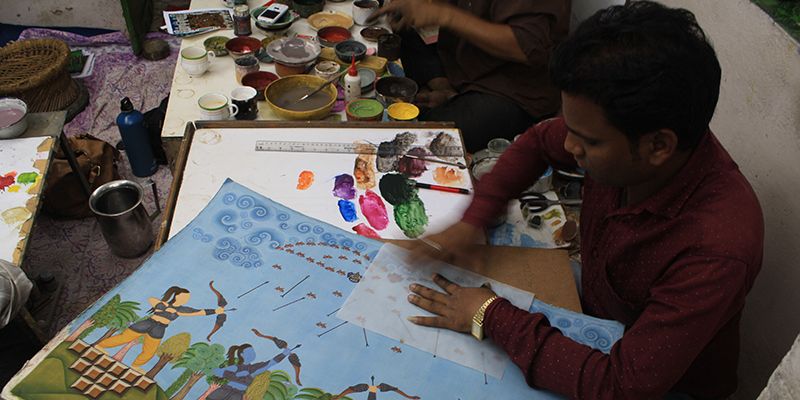A Maukaa to preserve Rajasthan’s dying art forms
Maukaa Art Foundation strives to give means of survival to Indian artists who do not see a future in passing the art form down to younger generations.
Despite having a rich heritage of arts, culture, and tradition, Rajasthan still does not have a formal institution which hosts artists or students to study the Indian classical art forms. The artist and the art continue to face hardships and are today on the brink of extinction. Hence, with an aim to not only revive and preserve these traditional art forms but also to get them internationally recognised, Prerna Jain founded Maukaa Art Foundation.

A home to preserve the legacy of the past
Desirous of fulfilling her childhood dream of becoming an artist, Prerna left California and moved to New York City to study art while continuing her professional work as a management consultant. The exposure and visits to revered art museums such as Metropolitan Museum of Art and Museum of Modern Art fuelled her passion. She decided to leave her well-paying job and move back to Jaipur, her hometown, after a four-year stay in the United States of America. However, her decision to learn the most revered art form of her own country proved to be the most challenging part.
With the aim of learning Indian miniature Art, 32-year-old Prerna scoured every street of the Pink City in search of art schools and artisans. Due to the lack of a properly institutionalised platform available in the state, she decided to chart her own course to preserve Indian art and restore its lost glory.
“Very soon, within a month of arriving, I had realised I was there for a bigger cause. I had to do something to create a multidimensional solution that would solve the problem of the declining Indian art and culture as well as restore the livelihood of the artists,” she says.

With a team of five members, Prerna founded Maukaa Art Foundation in September 2016 to safeguard traditional Indian art forms from extinction by bringing them into the organised sector. They are working on developing collaborations between young artists and traditional artists to present the art forms in a contemporary manner. The foundation wants to create a complete 360-degree ecosystem which will bring about a sustainable, visible change.
Through Maukaa, she hopes to revive the dying Indian miniature art form and preserve this legacy of her hometown. Through crowdsourcing, the various projects undertaken by the team include the formation of an art League, where anyone can come and learn techniques of traditional Indian art forms; manufacturing and supply of organic and natural stone pigments using traditional techniques; documentation of methods and materials of all art forms through blogs, audio-visual capsules; and providing online training and assistance to artists and students.

The foundation aspires to become an international role model in safeguarding Indian traditional art forms like miniature, phad, puppetry, kavad, and kalamkari from extinction. Through exhibitions at international arenas like Affordable Art Fair and Art Biennales, the team will work to restore the identity and dignity of the traditional artists. To encourage the practice of authentic traditional art among young artists and students, they produce handmade stone colours, organic pigments, squirrel hair brushes, and wasli (sheet) using age-old techniques. Further, by creating a database of all traditional artists and artisans, Maukaa aims to become a one-stop place for Indian art forms.
India needs to promote art and relish its rich history
Unlike the West, India is yet to celebrate art by preserving traditional techniques and passing the knowledge to newer generations. The USA, France, Netherlands, and Germany have various learning centres to teach classical American realism or Dutch painting methods to their art students. While India continues to lack in schools that teach classical art forms, Pakistan’s National College of Art in Lahore is perhaps the only institution in the world that still teaches the techniques of miniature art.
Sadly, most of the rich heritage of our past remains only as references in art history books. There are no art schools in India specifically dedicated to traditional art forms. Schools such as MSU Baroda, Sir JJ Institute, Kala Mandir, and Shantiniketan focus on the history of these artworks but not much on the craft.

“We are so blessed to have such strong history of our culture and art. It is indeed an advantage for us that we don’t have to look anywhere else for inspiration to create art. We need to tackle poverty—the fact that we have conveniently turned people from artists to artisans is upsetting,” Prerna says.
The steady decline in the number of artists who still practise traditional Indian art forms is a worrying trend. Indian miniature paintings, ancient and alluring, have today become extremely rare. Miniature art has a long history spanning centuries. Until 1300 AD, Indian artists painted religious texts either on palm leaves to create manuscripts or made frescoes. By the mid-1300s, paper and pigments arrived in India from Iran (Persia), after which this art form flourished till the 20th century, primarily in the Northern parts of the subcontinent—India and Pakistan.

Today, Prerna fears that this art is being practised by the last generation of artisans based in Rajasthan—Jaipur, Bikaner, Udaipur, and Jaisalmer. The skills and knowledge passed on through the generations have no takers left as the current practitioners themselves live a life of poverty as this art form fails to generate adequate revenue.
“Making these paintings is not only difficult but also a time-consuming process. To think this art form will have no heirs because we, as a society, didn’t do enough is a wake-up call. For obvious reasons, the artists no longer want to pass their skills to their next generations,” she adds.
Today art is a big industry in itself and with proper exposure and packaging, not only will the traditional art forms get recognised but artisans will also have a greater income and better livelihood. Acting as an umbrella organisation. Maukaa aspires to be a ray of hope for the artists who do not see a future in passing the art form down to their younger generations.








